Visitors who are keen on history and looking for things to do in Tasmania with a focus on the island’s rich past will love exploring the Convict Trail, which passes through the town of Richmond. Richmond, Tasmania, is one of the prettiest places on the Apple Isle.
It drops south, through the former grain town of Sorell – which has its own collection of prized 19th-century buildings – and Dunalley, a small fishing village. The A9 road then stretches out over Eaglehawk Neck, a 100-metre wide isthmus that connects mainland Tasmania with the Tasman Peninsula. There are some stunning natural sights in this vicinity, with a series of blowholes, cave formations and sweeping cliff-edge views.
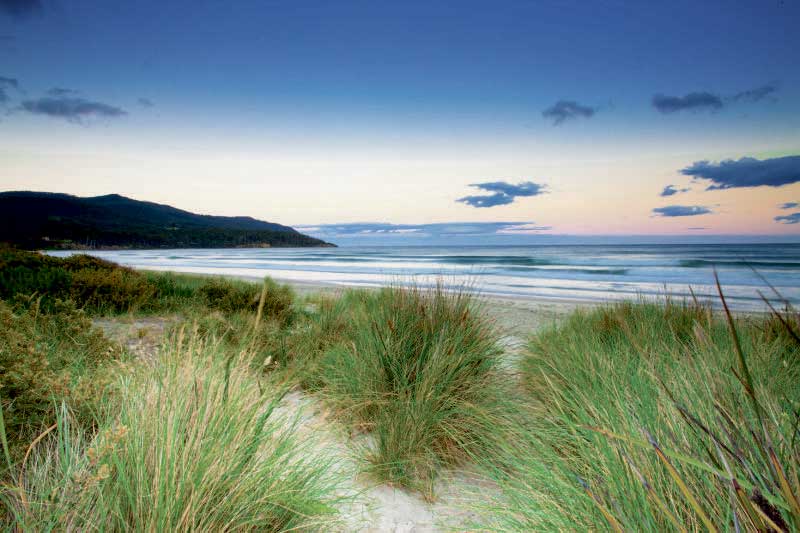
Contents
- Richmond Tasmania
- Richmond’s history
- The Vibe In Richmond
- 15 Things To Do In Richmond, Tasmania
- 1- Walk Across The Oldest Bridge In Australia
- 2- Admire St John’s Church
- 3- See St Luke’s Anglican Church
- 4- Visit The Richmond Courthouse
- 5- See The Old Post Office (1826)
- 6- Have A Beer At The Richmond Arms Hotel
- 7- Visit The Richmond Gaol
- 8- Wander Through Bridge Street
- 9- Visit Old Hobart Town
- 10- Zoodoo Wildlife Park
- 11- Go Wine Tasting in The Coal River Valley
- 12- Visit Coal River Farm
- 13- Pooseum
- 14- Pick Fruit At Littlewood Berry Farm
- 15- Explore Port Arthur
Richmond Tasmania
Richmond’s history
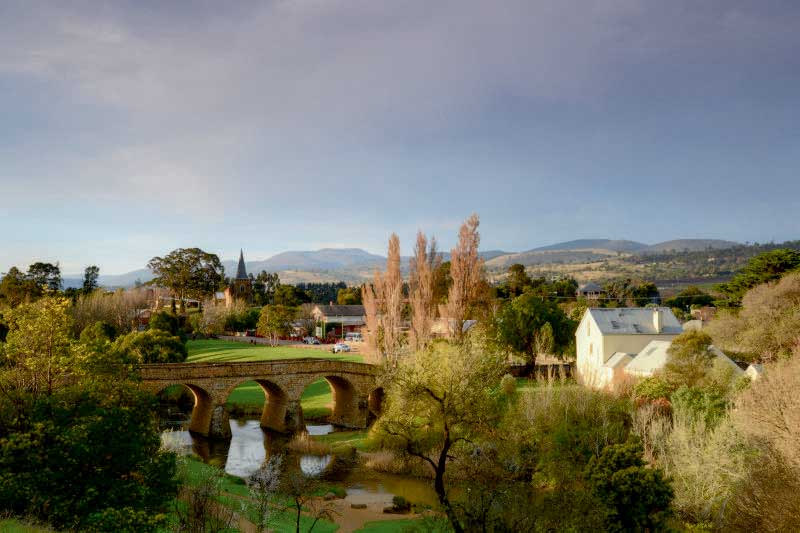
Founded in the early 19th century, 27km north of the Tasmanian capital, it’s part of the so-called ‘convict trail’, which snakes up from Hobart and down to the rugged Tasman Peninsula, where nestles the penal site of Port Arthur – one of Tasmania’s most visited tourist attractions.
Initially, a small farming community, Richmond transformed into a key military post and prison station after the construction of a bridge that linked Hobart with the east coast of Van Diemen’s Land (as Tassie used to be known) in 1823.
Neer-do-wells comprised much of the early population, although the area – under the authority of the strict Lieutenant-Governor, George Arthur – soon attracted free settlers, with publicans, blacksmiths, wheelwrights, saddlers and tanners setting up businesses here, sparking Richmond’s growth from village to town.
The boom ended after the 1872 opening of the Sorrell Causeway, which went from east to west and bypassed Richmond.
Shorn of its strategic importance, and with Port Arthur becoming the region’s dominant prison site, Richmond remoulded itself back into a small rural community, albeit one that is keen to showcase its significant heritage to tourists.
The Vibe In Richmond
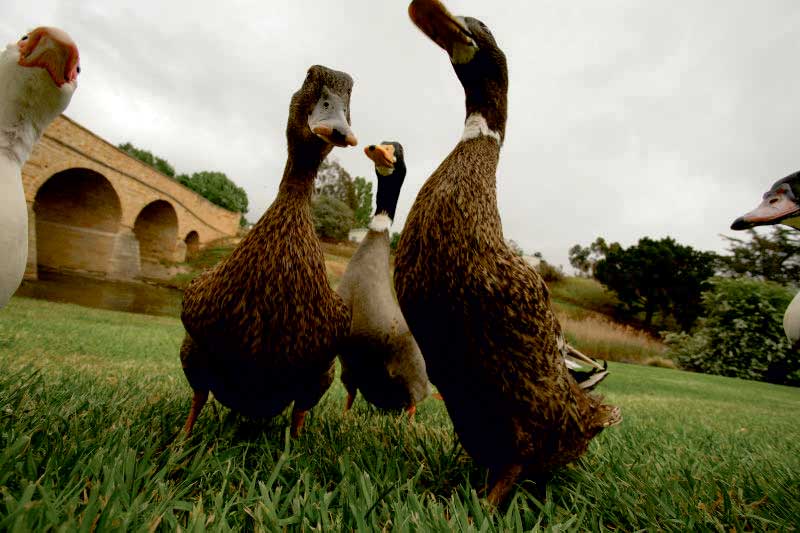
Trying to enjoy a nice picnic by the river isn’t easy when you’ve got pesky little yobs raging around threatening to steal your ham sandwiches.
It’s a type of anti-social behaviour you don’t really expect to endure when you roll into Richmond, Tasmania’s most quintessentially genteel English-style village.
But ducks will be ducks.
Around 50 of the blighters, of varying colours, shapes and sizes, frenetically patrol the grassy banks of the Coal River, making a cacophony of noise and generally annoying everyone in sight.
Two ducks, in particular, act like schoolyard bullies, terrorising a small, taciturn web-footed neighbour to breaking point.
One of the brutes has pinned down his victim and treads on his back, while his partner in crime stands upright, surveying the area like a burly doorman and making sure no-one intervenes.
You shouldn’t be surprised by this thuggery because, for all its undoubted beauty and tranquil nature, Richmond has a history of rebellious residents.
15 Things To Do In Richmond, Tasmania
Christina Pfeiffer
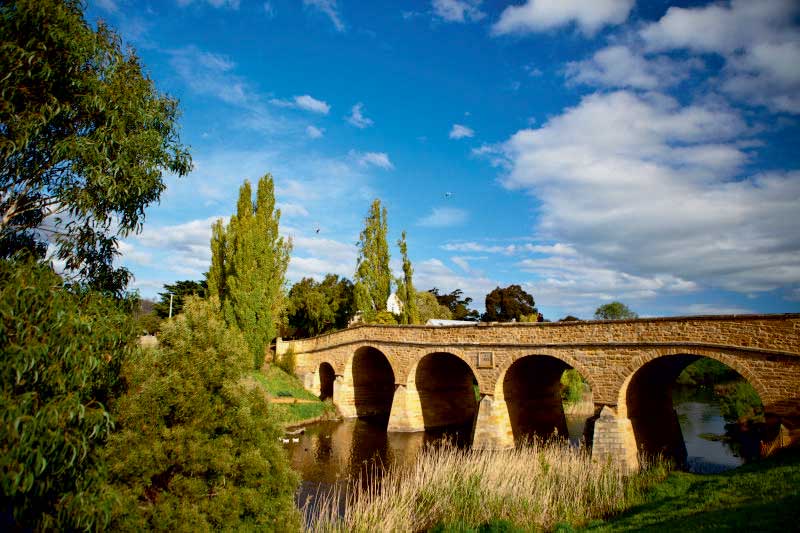
Even though Richmond has a rough past, walking around Richmond today, it’s no surprise that many consider this the most charming place in Tassie.
The town’s iconic sight is the convict-built bridge, which is the oldest of its type in Australia and still looks picture-perfect as it reflects into the river below – despite those irascible ducks that do their best to misbehave.
Things to do in Richmond are:
1- Walk Across The Oldest Bridge In Australia
Richmond Bridge is a heritage-listed arch bridge constructed from sandstone from Butchers Hill quarry that was moved by convict labour with hand carts.
The bridge is Australia’s oldest stone bridge listed on the Australian National Heritage List.
These sandstone arches have stood across the Coal River since 1825, and when it was built, it was considered a technological marvel for the colony.
It held the title as the longest spanning Australian bridge for 10 years and is still used today.
2- Admire St John’s Church
St. John Evangelist was built in 1836 and is Australia’s oldest Roman Catholic Church that is still operating.
Even though St. Mary’s Cathedral in Sydney was created first, the original chapel was demolished by fire in 1865.
St John is a place to escape, pray and to soak up the tranquillity in historical surroundings.
3- See St Luke’s Anglican Church
Another grand building in Richmond is St Luke’s Anglican Church, which has not changed since it was built in 1834.
The convicts also built this church, which has a distinctive timber roof.
St Luke’s was designed by Colonial Architect John Lee Archer and is a historic landmark to visit.
The church’s tower clock was one of six manufactured by London clockmaker Thwaites and Reed.
4- Visit The Richmond Courthouse
Originally a district of Van Diemen’s Land, which was part of the penal colony, Richmond was the district where Governor George Arthur appointed magistrates to oversee penal discipline in 1827.
It became a centre for the justice system, where council and court hearings for the surrounding regions were held.
Chain gangs of convicts built the roads and beautiful Georgian buildings between 1833 and 1838 under challenging conditions, experiencing food shortages.
5- See The Old Post Office (1826)
This group of Georgian buildings comprising a granary, store and residence was built in 1832 by James Kestall Buscombe.
Buscombe, who was the postmaster for Richmond, operated the post office from the Lennox Arms at first but moved the post office to another building in 1832.
The store had an impressive frontage with 20 windows, double entry doors and carved stone panels.
6- Have A Beer At The Richmond Arms Hotel
The Richmond Arms Hotel is a grand sandstone building constructed in 1827 and an excellent spot to stay in the historic town’s heart.
The building initially housed the Lennox Arms Hotel, which was razed by fire in 1888.
The Commercial Hotel replaced it and was later called The Richmond Arms.
Have a beer at the bar and a meal at the Bistro Lounge, while soaking up the atmosphere of old Tasmania.
The Stables has renovated accommodation with bathroom facilities.
7- Visit The Richmond Gaol
Richmond Gaol was built in 1825, five years before Port Arthur opened its gates, and has been remarkably well preserved.
Visitors can peruse the gaol’s solitary confinement and punishment cells.
The oldest gaol in Australia dates back to 1825 and is the place to get the feel of 19th-century convict hardships, as not much has changed since the days when it housed notorious inmates such as Ikey Solomon.
The Richmond Gaol is older than Port Arthur and has a small female solitary confinement cell, where female prisoners were confined in a space measuring 2 m by 1 m.
The buildings include a flogging yard, cookhouse, sleeping quarters, holding rooms, and historical items and documents.
8- Wander Through Bridge Street
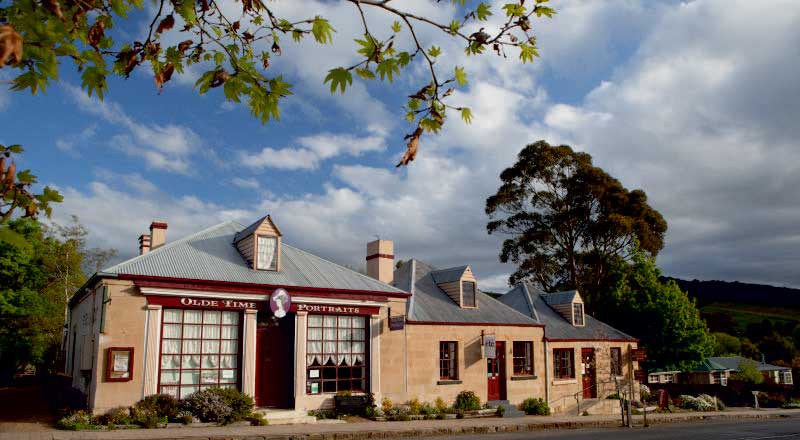
A raft of delightful old Georgian cottages and manors line Richmond’s main thoroughfare, Bridge Street, and there are a handful of B&Bs, neat cafes, arts and craft galleries and boutique shops.
9- Visit Old Hobart Town
Further along is Old Hobart Town, a model village depicting Hobart in the 1820s.
Recreated from the city’s original plans, it’s both authentic and informative and also makes you feel ten feet tall.
The Old Hobart Town Model Village is a perfect setting to learn about early settlers’ lives in Hobart as you walk through a miniature replica of Hobart as it was in the 1820s.
There are over 60 building models, a few hundred figurines, trees and other structures.
Wander around, read the signage about the past’s fascinating tales, and look at old photos.
Next door is the wooden-walled Richmond Maze, where children love getting lost while the oldies relax in the adjoining tea rooms.
Anyone wanting to dig deeper into Richmond’s history can enjoy guided walks through town, or even a horse-drawn carriage ride.
10- Zoodoo Wildlife Park
Zoodoo Zoo is a 90ha wildlife safari and native animal park.
You can see various wildlife from around the world such as Tasmania devils, lions, meerkats, marmosets and servals.
The zoo offers personal animal encounters, such as the Australian Encounter, where you can get close to three Australian animals such as gliders, Tassie devils and Eastern quolls, and the behind-the-scenes Lions encounter.
Zoodoo is open every day from 9 am to 5 pm.
11- Go Wine Tasting in The Coal River Valley
The Coal River Valley is an old wind region with over 20 wineries and cellar doors.
Top wineries to visit are:
Pooley Wines (1431 Richmond Rd, Richmond) – The cellar door is open from 10 am to 5 pm every day and offers local cheese and charcuterie.
Puddleduck Vineyard (992 Richmond Rd, Richmond) – The cellar door is open from Monday to Sunday (10 am to 5 pm). Bring your own picnic or order from their pecking menu.
12- Visit Coal River Farm
Coal River Farm makes cheese and chocolate and is a lovely spot for a leisurely lunch in the country.
Pick strawberries, cherries, apricots, and plums; watch the chocolatiers and cheesemakers create award-winning products.
The farm’s Washed Rind cheese was a Gold Medalist at World Cheese Awards in Italy, and the Triple Cream Brie has also won several medals.
The farm is home to chooks, pigs and goats.
Coal River Farm is at 634 Richmond River Road, Cambridge.
13- Pooseum
Pooseum is a fascinating attraction with displays and educational information on how poo is used for energy production, biogas and medicine.
14- Pick Fruit At Littlewood Berry Farm
Since the 1800s, Tasmania has been a farming region, and fruit picking is one of the fun activities.
Pop into Littlewood Berry Farm for icecream, to pick fruit or buy jams and sauces.
15- Explore Port Arthur
If ever a place encapsulated the beautifully-haunting nature of Tasmania, it’s Port Arthur; a site brimming with both sumptuous scenery and dark tales of the past.
Old prisons are supposed to be grotty, dirty and inhospitable.
Yet, with its delightfully green surroundings and elegant Georgian architecture, Port Arthur is anything but.
However, lurking beneath the verdant setting are tales of grim-faced horror that stretch back to when Tasmania – or Van Diemen’s Land – was a dumping ground for some of the most hardened British criminals.
The penitentiary was, according to English prison reformer Jeremy Bentham, ‘a machine to grind rogues honest’, and its tools were discipline and punishment, religious and moral instruction and training and education.
Prisoners were also forced to work in local mines (the Coal Mines Historic Site is a 25 minutes’ drive from Port Arthur, near Saltwater River on the northwestern tip of the Tasman Peninsula).
Port Arthur was dubbed an ‘escape proof’ gaol upon its opening in 1830. Naturally, several inmates tested the validity of this theory over its 47 years of existence.
Those who did survive and were recaptured maybe wished they hadn’t, such was the horrific nature of sentences meted out; for instance, would you prefer to be flogged to within an inch of your life, or kept in solitary, dark and silent confinement for 23 hours a day?
When you hear all this – and you hear plenty of stories on the excellent guided tours – it’s hardly a shock to discover the authorities had to ultimately build an asylum on site.
As you explore Port Arthur, you’ll struggle not to admire the buildings that the convicts built, although some are little more than ruins these days.
More than once you’ll probably wonder if all those grim tales are really true, such is the bucolic, kindly calmness of this place.
Port Arthur was reintroduced to tragedy in 1996 when a lone Hobart gunman went on a killing spree at the site’s Broad Arrow Cafe, murdering 35 people and wounding several more.
A memorial garden was established around the shell of the cafe that was gutted following the massacre.
Fittingly, it’s eerily silent.
When nightfall arrives, Port Arthur takes on a different character and the best way to exploit this is by joining the popular lantern-lit ghost tours, where you’re told creepy tales about the site’s past – and present.
It’s a touch contrived at times – there are plenty of cliched moments involving slamming doors and dark shadows – but it’s good fun nonetheless.
Actually, I say, it’s fun, but it makes the drive back to Hobart a little unnerving.
Add a dark, winding road with rogue wildlife hopping in front of you – kangaroos and wallabies – and the feeling that someone – or something – is breathing on the back of your neck, and you’re rather on edge.
And I can’t help but think: it must have been hell trying to escape from Port Arthur at night.
Plan Your Trip

Rent A Car – Find the best car rental rates at Discover Cars. They compare car hire companies to provide you with the best deal right now.

Find A Hotel – If you’re curious about this article and are looking for somewhere to stay, take a look at these amazing hotels.





